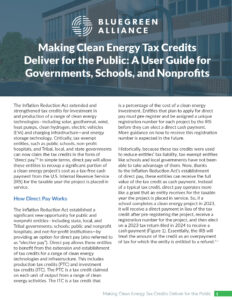Making Clean Energy Tax Credits Deliver for the Public: A User Guide for Governments, Schools, and Nonprofits
The Inflation Reduction Act extended and strengthened tax credits for investment in and production of a range of clean energy technologies—including solar, geothermal, wind, heat pumps, clean hydrogen, electric vehicles (EVs) and charging infrastructure—and energy storage technology. Critically, tax-exempt entities, such as public schools, non-profit hospitals, and Tribal, local, and state governments can now claim the tax credits in the form of “direct pay.” In simple terms, direct pay will allow these entities to recoup a significant portion of a clean energy project’s cost as a tax-free cash payment from the U.S. Internal Revenue Service (IRS) for the taxable year the project is placed in service.
Direct pay is a transformative opportunity for tax-exempt entities to build and produce clean energy and infrastructure. Starting in the fall, entities who wish to access direct pay will need to pre-file with the IRS for each clean energy project. To prepare for this, entities will need to identify which tax credits they will claim as well as which tax year they are filing for. This will generally be the year the project is placed in service.
The pre-filing process will also ask for information about the project that demonstrates eligibility for any bonus credits an entity is pursuing—like the domestic content bonus, energy communities bonus, and low-income communities bonus. Once the pre-filing process is completed, the IRS will issue a registration number that will be included when an entity files its taxes at the end of that taxable year. project that demonstrates eligibility for any bonus credits an entity is pursuing—like the domestic content bonus, energy communities bonus, and low-income communities bonus. Once the pre-filing process is completed, the IRS will issue a registration number that will be included when an entity files its taxes at the end of that taxable year.
Find out how , tax-exempt entities, such as public schools, non-profit hospitals, and Tribal, local, and state governments can access this exciting opportunity by downloading the full user guide below.
